by Winding Pathways | Mar 14, 2024 | 1080 Labyrinth Blog, Labyrinths, Reflections/Profiles, Uncategorized
Who Is Stargirl?
Stargirl taught us to notice…to care. You know Stargirl, the spritely, hippie-seeming girl in the Jerry Spinelli story of the same title who showed up at a high school, wrote notes to people, played the ukelele, was nice to everyone, and even cheered the other team’s successes. She turned typical high school life upside down. And, then, vanished.
We walk today in her spirit. Usually ground underfoot is stone-cold and rigid. But with this “winter that hasn’t been” mole humps yield underfoot. We pause by the bell of the Phoenix Harmony Labyrinth.
Cookie Monster has nibbled the rim of the waning Gibbous moon as it slips west. Guided by moon shadows we walk.
-
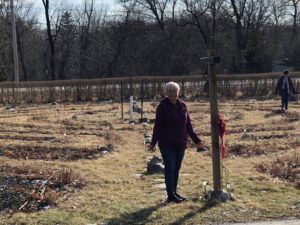
-
Teri blesses the labyrinth
-
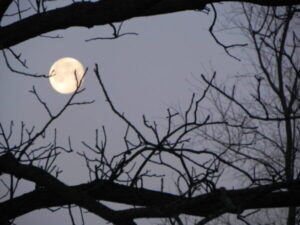
-
Tree branches help you watch the moon move across the sky.
From the south Mother West Wind shakes out the Merry Little Breezes. Off they skitter tickling the tops of the firs and rustling the winter-weary leaves of the Derecho-damaged oak.
Four Directions
Stop. Breathe in the air. Neither too cold nor too muggy. It’s Goldilocks. Just right.
To the east, a smear of red on the horizon separates the black earth from the velvet sky. Father Sun, starting to wake up, stretches his rosy fingers. Yet, stars still sprinkle the sky.
The ancient basswood tree full of gaping holes stands silhouetted. How did it survive when the sturdy oak shattered? Perhaps because it didn’t resist?
Totems
Vultures return in March. In fact, I saw one the other day soaring overhead. Checking out the basswood that has been home of vulture families for generations. Some people don’t like vultures because they are homely and eat dead stuff. Who among us is a Hollywood beauty?
As for eating dead stuff, good thing they do…One of Mother Nature’s cleanup crew. Otherwise, we would be knee-deep in rot. Maybe we are anyway. Good parents their keen eyesight and sharp smell lead them to meals which they feed their babies until they fledge.
Watching the young on their first flights as they swoop down, cross the labyrinth, then flap mightily to land in the fir on the far side is always a thrill. Vultures are good totems.
The pause by the birches feels like home. New England. Robert Frost wrote it well: “When I see birches bend to left and right Across the lines of straighter darker trees, I like to think some boy’s been swinging them. But swinging doesn’t bend them down to stay. Ice-storms do.”
Call and Response
Ahh, off in the woods a call and response as two cardinals awaken and call. A turkey gobbles from a tree top.
At the Center of the labyrinth, I thank the earth elements, plant and animal kingdom, those I have known. I send Grace to those I dislike, which helps me most. I stop and thank guides and Divine love.
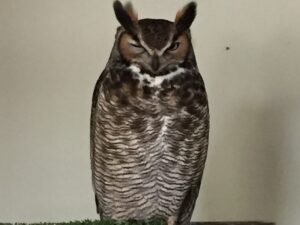
Injured owls find a safe home at the International Owl Center.
An owl floats past. Silent yet hearing, unseen yet seeing all. Quiet knowing. Carrying us through the night into the day.
To the north the Big Dipper’s handle swings off to Arcturus and look! A shooting star blazes brightly dropping into the North Star.
Stargirl is with us.
by Winding Pathways | Nov 23, 2023 | Uncategorized
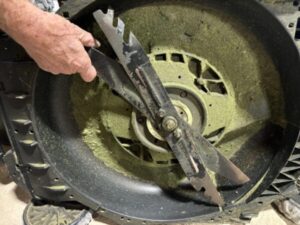
Two blades chop up leaves.
A few years ago we found a way to make removing leaves fast, easy, and good for the lawn. We actually don’t remove them but mulch ‘em in place.
We’re old enough to remember childhood autumns when homeowners raked their leaves to the curb and set them on fire. Smoke wafted throughout the neighborhood.
For good reasons, many towns banned leaf burning and began picking up and composting leaves. It’s a great change, but there’s a better way.
Raking is a monotonous chore. Leaf blowers herd leaves to the curb while filling the neighborhood with dreadful noise that sounds like a magnum force dentist’s drill.
We don’t like raking and won’t use a blower. Instead, we mulch leaves right on the lawn. Our battery-powered mower gives us an easy and environmentally appropriate way to convert them into lawn fertilizer. At the same time, we help small pollinating insects in the hibernation stage and small amphibians among other helpful creatures.
We bought an EGO mower a few years ago that has two blades that effectively chop leaves into tiny pieces that filter downward beneath grass blades. Eventually, tiny leaf pieces decompose to add nutrients to the soil that next year’s lawn grass will appreciate and use.
Unlike blowers, our battery-powered mower operates quietly. Our neighbors probably can’t even hear it.
Note: We purchased our EGO mulching mower at full retail cost.
by Winding Pathways | Jul 20, 2023 | Reflections/Profiles, Uncategorized, Weeds
Wisdom From “Johnny Appleseed” of Prairie Plants
“Weeds are mother nature’s stitches,” prairie restorationist Corliss “Jock” Ingels told us years ago.
“If you badly cut yourself, a physician stitches the wound closed so it can heal. If you bare the ground, weeds quickly sprout, shading the soil with foliage and filling it with roots. Weeds reduce erosion until more permanent plants take hold,” he proclaimed.
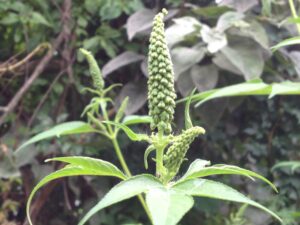
Even rag weed has a purpose. Birds love the seeds.
On a hot summer morning, we pedaled along the Grant Wood Trail, seeing mother nature’s stitches alongside the new pavement. Recently the popular bicycle trail was paved. Machines bared the soil at the edge of the pavement that’s now covered with bright yellow trefoil, crown and purple vetch, golden dandelions, white spurge, sweet clover, ragweed, and poison hemlock. All are so-called invasive weeds, but they’re providing a service by holding the soil and giving homes to trailside wildlife until more “desirable” plants establish. Some of those pioneering weeds sported an array of bright flowers that made our morning ride delightful.
Beyond Human Centric
Weeds have a purpose, but must a plant or animal need to have a “human-centric” perspective?
The night before our bike ride we sat on our back deck with Neil and Renata Bernstein. He’s a recently retired biology professor and remarked that sometimes people ask what purpose a particular plant or animal has.
Purpose! Must plants and animals have a purpose from a human perspective?
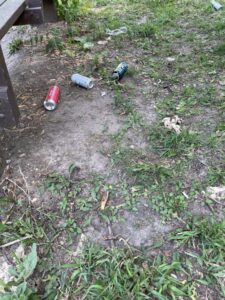
Easily recycled cans become trash.
Dr. Bernstein sometimes responds to these questions by saying, “What’s the purpose of people?” Indeed, our observations are that modern humans have forced out original people from their lands. We have done a great deal of harm by polluting the air, siphoning off life-giving water to maintain green grass, and stripping the land of topsoil, precious metals, and crystals. We greedily take a resource, convert it to our own purpose, then throw it away. “What’s the purpose of people?”
More to Purpose Than Our Perspective
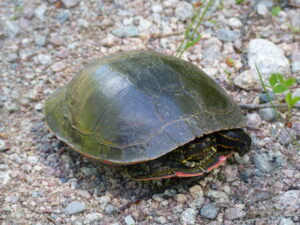
We can learn much from turtles.
Some living things certainly have a great purpose. Without wheat, cattle, corn, penicillin mold, lumber, trees, and thousands of other plants and animals we couldn’t live. Others may seem to have a negative purpose. Think disease-causing microbes, poison ivy, ragweed that spews allergic pollen into the air, mosquitoes, and a host of other creatures that cause human misery. To view them negatively is human-centric.
The vast majority of living things neither produce tangible benefits nor problems for people. Like turtles, they simply live. Probably they have a valuable ecological role that may not be obvious but they are here. They have a right to be here whether or not they provide human impact. As we have learned over millennia, different plants and animals, offer benefits to us. We simply have to observe and incorporate.
To Everything…There is a Purpose
Every living thing has a purpose in the great scheme of things that people barely understand.
So, as we cycle along, we doff our bike helmets to the diversity of life we pass and silently thank them for sharing the world with us.
by Winding Pathways | Feb 3, 2022 | Birds, Garden/Yard, Nature, Uncategorized
Millions of families love watching chickadees, nuthatches and woodpeckers visit backyard feeders. A joyful daily task is bringing them a day’s supply of sunflower seeds, millet, or even cracked corn. But, often an important part of their diet is ignored.
Birds lack teeth so never need dental care. Instead, they must eat rocks! Small rocks humans call sand. Often birds forage along snowy roads gleaning grit spread to give cars traction. It goes into their gizzard where powerful muscles grind seeds into a digestible slurry that then moves on to the stomach.
During most of the year, birds find all the grit they need on their own, but when snow and ice seal off the soil they can’t find it. People sometimes scatter sand on slippery spots to provide human traction. Birds will glean some of it.
It’s helpful to sprinkle a handful of sand around feeders once a week during the snowy season. At Winding Pathways, we buy a 50-pound bag of chick grit at a local store that sells chicken feed. It’s fine ground hard rock that is ideal for both traction and bird digestion but plain old sand works.
Wild Turkeys often visit our feeders, so once in a while, we toss out large-sized grit, designed for laying hens. It helps their gizzards grind up hard corn kernels that they love snacking on.
An outstanding source of bird information is the Cornell University Laboratory of Ornithology.
-
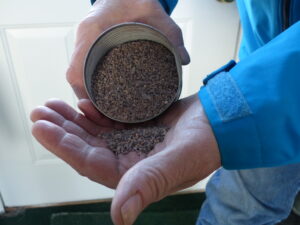
-
Chick grit is small.
-
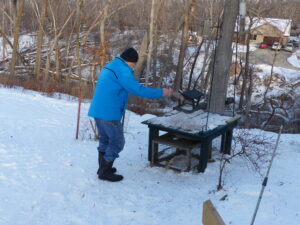
-
Sprinkle grit once a week to help birds in the snowy season.
-
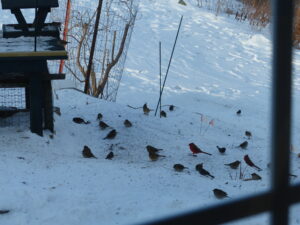
-
Birds flock to the seeds.
by Winding Pathways | Dec 23, 2021 | (Sub)Urban Homesteading, Energy Efficiency, Uncategorized
We knew natural gas prices were way up but our $80+ November bill both surprised and pleased us.
Surprise: That’s a high bill for us.
Pleased: Our efforts at energy efficiency and wise house management kept the bill from being higher.
Nearly everyone can reduce heating costs. Some actions are long-term, like adding insulation, replacing drafty windows, or installing a wood stove. There’s not enough time this year to put these in place this winter.
Here are short term ways to reduce the heating bill at either no, or low, cost:
- Open south-facing window blinds on sunny days. The sun will warm the room and never send a bill. Close the blind when the sun calls it quits and sets for the day.
- Caulk holes and cracks. We bought a spool of “rope caulk”. It’s putty that won’t harden, comes in a roll, and is easy to press into cracks, especially around windows.
- Replace the furnace filter. If it gets clogged with dust the furnace has to work harder, and that costs money. Write on the filter the date you replace it so you know. Then, make a note on your planner to check and replace. Some furnaces also send alerts to change a filter.
- Wear comfy sweaters and socks and set the thermostat down a few degrees. We often nestle under a blanket or throw when watching tv or reading in the evening.
It’s going to be an expensive heating winter, but taking a few simple efficiency steps will remove some of the monthly bill’s sting.
by Winding Pathways | Nov 25, 2021 | Mammals, Nature, Preparedness, Uncategorized
Two years ago, hardly anyone knew what the novel Coronavirus was, but since then this crafty virus and the nasty disease it causes, COVID-19, has hardly been all over the news. Like most people we thought it was a disease of only humans.
We were astonished to learn that a high percent of Iowa tested deer has been found positive for COVID. With deer hunting season approaching we wondered if deer pose a threat to people either butchering an animal or eating the meat. So, we contacted Dr. Tyler Harms. He’s the Iowa Department of Natural Resources Deer Program Leader.
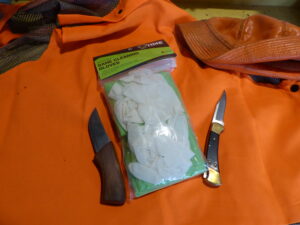
Dr. Tyler Harms, head of deer project in Iowa recommends safety gloves and hand washing when processing and preparing venison.
According to him the threat seems minimal, however, he recommends the following actions for anyone processing a deer:
- Wear rubber gloves when processing an animal.
- Wash hands and equipment thoroughly after handling deer meat
According to Dr. Harms, Iowa’s deer are asymptomatic. They don’t seem to be getting sick or dying.
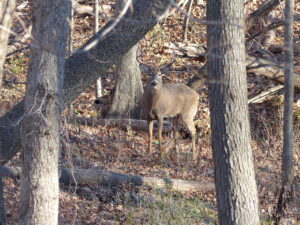
Bucks are still active in December.
December is Iowa’s main deer hunting season. Over 100,000 animals are likely to be harvested. Here at Winding Pathways, we enjoy venison as local, organic, free-range meat. But we’ll be sure to follow Dr. Harm’s advice when handling meat.
In many ways COVID is a mysterious disease. Where it came from remains a hazy mystery, and its variants continue to perplex people. Now it’s been found in animals. Iowa’s deer aren’t the only animals that test positive. The disease has been found in leopards in zoos and mink. It’s likely that many other animals and deer nearly everywhere carry COVID. How they got it and how it’s spread is a mystery.












